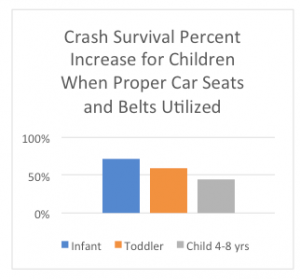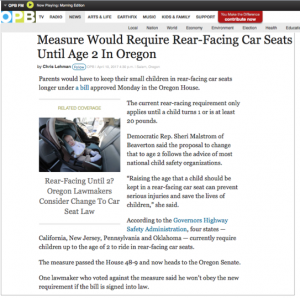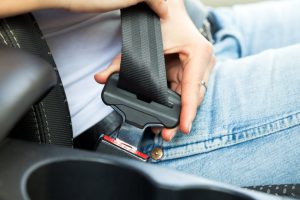How To Reduce Major Injury Risk By 50% In A Motor Vehicle Crash
What is the single most effective action Oregon residents can take to protect themselves and family members in a motor vehicle crash?
While it might seem like an obvious answer or a topic that has been overplayed throughout the years with national “Click It, Or Ticket” campaigns, seatbelts still cut the risk of a serious injury by 50%. Yet, I was shocked to learn that preliminary Oregon crash reports from last year indicate that 32% of motor vehicle occupant fatalities were NOT using safety belts.
Could we have a seat belt compliance problem in our own back yard?
The NHTSA believes Oregonians are very seatbelt friendly and reports our percentage of compliance for seat belt use as one of the highest in the nation at 96% — substantially higher than the average US compliance of 90%[2]. Yet, other reports do not paint such a rosy picture. A statewide seat belt use survey reported 37% of front-seat motor vehicle occupants do not routinely use restraints, according to a KQEN News Radio[3].
In February, a statewide Oregon safety belt enforcement blitz was conducted for two weeks. Officers focused on 1) enforcement of seat belt safety laws, as well as, 2) distracted driving and 3) speeding – the three most significant factors contributing to motor vehicle crashes and their associated injuries and deaths.
Oregon-wide Safety Belt Enforcement Blitz Nets 5,408 Safety Belt and Child Seat Violations in 2 Week Period
Initial reports of the blitz results were very telling. Washington County Sheriff’s Office reported during the 2-week blitz 145 seat belt violations were issued, along with 355 speeding violations[4]. Crook County Sheriff’s Office reported that in just one 29-hour period they made 35 stops for failure to wear seat belts, 9 stops for speeding, and 8 stops for distracted driving[5]. It is hard to believe that seatbelt violations exceeded both speeding and distracted driving combined! Oregon wide statistics during the blitz included the following violations and contacts: 5,169 safety belt, 239 child seat, 5,944 speeding, 39 DUII, 767 suspensions, 149 felonies, and 9,609 other violations[6].
With such overwhelming evidence that seat belts save lives, why doesn’t everyone use seat belts?
Seat Belts Serve Multiple Purposes

People not wearing a seat belt are 30 times more likely to be ejected from a vehicle during a crash
By preventing ejection, seat belts greatly minimize the chances of motor vehicle crashes resulting in your death. In addition, NHTSA published a research report which explained the impact of wearing lap/shoulder seat belts on front-seat passengers. The report revealed that those who wore a seat belt reduced their risk of moderate-to-critical injury by 50% and fatal injury by 45%.
Proper Seat Belt Usage For Children
The benefits of wearing seat belts are even more startling when it comes to protecting our families. Motor vehicle crashes are the leading cause of death for children ages one through twelve. This number is attributed to two main factors: non-use of child car seats, and improper use of child car seats. Proper use of child car seats can increase crash survival by 71% for infants, and by up 
- Infants to ride in rear-facing car seats until they are one year old and 20 pounds. Update: Oregon is currently trying to pass a bill (House Bill 3404) to amend this law, so parents would have to keep children in a rear-facing car seat until their 2nd birthday. Four states – California, New Jersey, Pennsylvania and Oklahoma – currently require children up to the age of 2 to ride in rear-facing car seats.
- Children over one-year-old, between 20 and 40 pounds, must be in a forward-facing car seat.
- Children who weigh over 40 pounds must be properly secured in a booster seat until they are eight years old or 4′ 9” tall.
- Children who are over eight years old or 4′ 9” and all adults must be properly secured utilizing normal seatbelts.
According to the Oregon Department of Transportation, there is no Oregon law specifically prohibiting children from riding in the front seat of passenger vehicles. However, a rear-facing infant seat cannot be placed in a front seating position that is equipped with an airbag because this would violate Oregon’s requirement for “proper use” of a child safety seat[1]. In addition, there is a national “best practice recommendation” from NHSTA calling for rear seating through age twelve.
Motor Vehicle Crash Attorney

If you or someone you know has been injured because of another person’s conduct, and you are looking for a skilled attorney to lead you through the insurance roadblocks, please call today for a free and confidential case evaluation. Local (503) 610-0005, Toll-free 1-800-949-1481, or email travis@mayorlaw.com.
Additional Help
For additional information about personal injury cases, insurance, and maximizing your financial recovery, I recommend the following articles on my Blog:
Travis Mayor Named Rising Star by Oregon Super Lawyers
8 Mistakes Insurance Companies Are Hoping You Make!
Oregon Car Insurance and Personal Injury Claims FAQs
Oregon Personal Injury Case FAQs
What is my Personal Injury Case Worth?
[1] Source: https://www.oregon.gov/ODOT/TS/pages/safetybelts.aspx.
[2] Source: NHTSA
[3] Source: http://kqennewsradio.com/2017/01/25/february-safety-enforcement-blitz/.
[4] Source: http://www.co.washington.or.us/News/SONews/upload/PR170224-February-Seat-Belt-Blitz-Results.pdf.
[5] Source: http://www.ktvz.com/news/crook-county-so-details-traffic-safety-blitz-results/356611405.
[6] Source: https://www.oregon.gov/ODOT/TS/pages/safetybelts.aspx#Click_It_or_Ticket-Enforcement.

